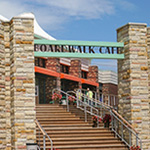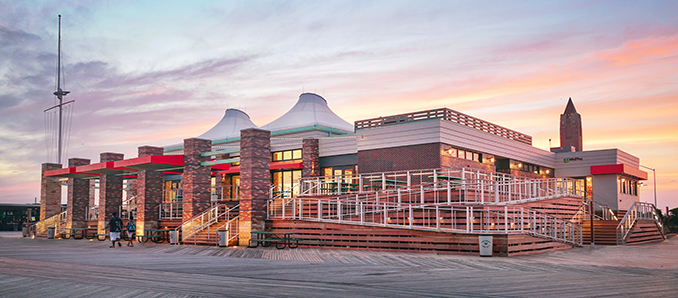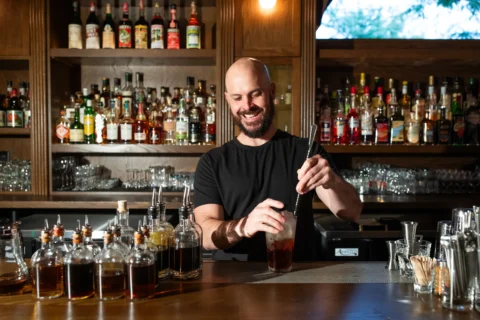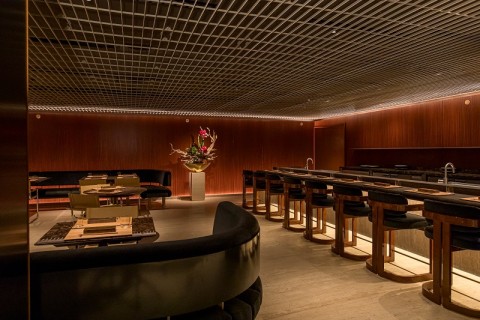 The LiRo Group served as construction manager for the new, $20 million Boardwalk Café building and Phase II of the East Games Area at Jones Beach State Park, New York State’s second-most visited park, trailing only Niagara Falls. In 2017, Jones Beach drew 5.95 million visitors. The project is part of Governor Andrew M. Cuomo’s NY Parks 2020 initiative. The Cafe was designed by Beyer Blinder Belle Architects & Planners (BBB) and Studio Rhodeside Harwell Landscape Architecture designed the East Games Area.
The LiRo Group served as construction manager for the new, $20 million Boardwalk Café building and Phase II of the East Games Area at Jones Beach State Park, New York State’s second-most visited park, trailing only Niagara Falls. In 2017, Jones Beach drew 5.95 million visitors. The project is part of Governor Andrew M. Cuomo’s NY Parks 2020 initiative. The Cafe was designed by Beyer Blinder Belle Architects & Planners (BBB) and Studio Rhodeside Harwell Landscape Architecture designed the East Games Area.
“The project encompassed the construction of a new one-story concessions building and an outdoor games park,” said LiRo Vice President Frank S. Franco, AIA.
New York State Parks Commissioner Rose Harvey said, “The Boardwalk Café will be the place to relax and take in all the action along the boardwalk and beach. I’m grateful for Governor Cuomo’s leadership in revitalizing the public spaces at Jones Beach and providing the very best recreation and tourism opportunities to residents and visitors all across New York.”

According to BBB Managing Partner Frederick A. Bland, FAIA, AICP, “The design team wanted the utilitarian food service structure to make an architectural statement at a pivotal location where the Central Mall intersects with the boardwalk and the beach. We wanted to honor the architecture of the former restaurant and seamlessly embed the new structure into its surroundings, while accommodating the client’s need for a modern, functional facility that would effectively serve tens of thousands of visitors every year.”
The Boardwalk Café’s history dates back to the 1930s. A fire destroyed the original café in 1964, and its replacement restaurant, opened in 1968, was closed in 2004 due to structural failures.
Due to the low-bearing, sandy soil, the new building is erected on the foundation system of 52 12-inch steel H-piles driven 45 feet deep into the ground and 32 16-inch steel pipe piles driven 31 feet into the ground.
The poured-in-place concrete floor of the building is elevated 20 feet above sea level to protect the structure from potential natural disasters. The building features a steel structural frame with brick front and side exterior walls and a siding-covered rear wall. To maintain visual consistency of the park, the new structure’s architecture is an updated interpretation of the original Jones Beach buildings, erected in the 1930s.
In addition to the open central dining area, called the Market Hall, the new building houses offices of the concessionaire Centerplate and the zipline operator WildPlay, a kitchen, storage rooms, and public restrooms. Centerplate operates the restaurant and offers a variety of healthy and traditional summer foods.
The LiRo Group and other members of the construction team completed the project within a challenging, accelerated schedule of only ten months, despite the inclement weather conditions during the previous winter. “Several extreme cold periods would have typically prevented the pouring of concrete, which cannot cure in low temperature, delaying the completion schedule,” explained LiRo’s Project Manager Sal Grasso. “However, we addressed this issue by erecting temporary tents and using space heaters to allow the concrete pouring to continue. When the weather improved, we also extended work to 10 hours per day to further accelerate the construction schedule.”
During the excavation phase, the team faced a high water table due to the site’s proximity to the ocean. To counteract this, the crews erected cofferdams and used high-capacity pumps to allow the excavation to proceed on schedule.
“Beyer Blinder Belle, along with landscape architecture firm Studio Rhodeside Harwell, led a multi-disciplinary team to develop a conceptual revitalization master plan for the future of Jones Beach Park. The new Boardwalk Café was a part of the overall plan for the Park,” explained BBB Associate Noerah F. Alvi,
AIA, LEED AP. “The Café features an expansive outdoor area, including two levels of ipe wood terraces with tables, so that visitors can enjoy views of the beach and the ocean while having a meal or refreshments. Meanwhile, the new structure’s architecture recalls the vocabulary of the earlier Robert Moses-era building. For example, the exterior features bricks of similar size and color as other original structures within the Park, as well as traditional brick piers, awnings, and the colonnade,” she added.
One of the design challenges was FEMA’s requirement that the building is elevated 20-ft above the water level. “We camouflaged the pile system that supports the building with cascading outdoor dining terraces as well as landscaped berms,” said Bland. The building’s perimeter was wrapped with a new decking for the outdoor dining area.
The most interesting – and dramatic – architectural feature of the new Café is the 2,050-square foot tensile fabric roof of polytetrafluoroethylene (PTFE) Teflon®-coated woven fiberglass membrane stretched over the centrally located main dining and service area. BBB specified this system to visually connect the Café to the nearby games area, which features similarly shaped shade structures. The tensile roof system includes two metal poles and a structural metal frame on the perimeter. The remainder of the building features a standard flat roof. “To increase the building’s visibility at night, we installed a lighting system that illuminates the semi-translucent fabric roof from inside. To make it even more visually prominent, the colors of these lights change, creating a strong, playful presence visible from a great distance,” said Alvi. Another interesting element of the lighting system is the LED light strip hidden underneath the handrails of the exterior stairs.
The East Games Area’s children’s section features a new 2,000-square foot splash pad Adventure Course with an 85 gallons-per-minute water flow Vortex Splashpad system consisting of 20 spray features; sculptural, dune-shaped concrete features with a partial rubber pellet finish in earth tones and blues; decorative side walls of cast-in-place concrete with natural sandstone facing; water-resistant Brazilian ipe wood and stainless steel benches with embedded electrical illumination; and four steel shade structures with PVC roofs anchored in concrete footings, with uplights illuminating them at night. The adult games area features shuffleboard courts, concrete table tennis tables, a bocce ball court with shade structures, a bean bag toss area, teak lounges, and ipe tables and benches with umbrellas.
The LiRo Group
The LiRo Group, a national project and construction management, architecture, engineering, and technology firm, was founded in 1983. Headquartered in Syosset, New York, the company operates regional offices throughout New York State, in New York City, Hicksville, Holbrook, Buffalo, and Rochester. LiRo’s offices are also located in Jersey City, New Jersey; Scranton, Pennsylvania; and Stamford, Connecticut. The company employs over 900 construction managers, engineers, architects, planners, BIM and GIS specialists, and other construction and support professionals nationwide. LiRo’s 2017 revenues exceeded $400 million.
LiRo’s current and recent projects in New York City and in the greater New York area include the $10.2 billion East Side Access Long Island Rail Road expansion; the $30 million restoration of Pier A and the $12 million SeaGlass Carousel in Battery Park; the $60 million CUNY School of Architecture; $180 million worth of projects at the Brookhaven National Laboratory, including the National Synchrotron Light Source II; the $228.5 million High Line Park; the new $600 million Kosciuszko Bridge; the new $3.8 billion Tappan Zee Bridge; the $240 million Staten Island Siphon tunnel; the $2.4 billion Number 7 Subway Line Extension; the $220 million Governors Island, New York, Infrastructure Improvements; the $363 million Build It Back post-Hurricane Sandy housing recovery program; the $750 million housing recovery program for the New York State Governor’s Office of Storm Recovery (GOSR); New York City’s $640 million post-Hurricane Sandy Rapid Repairs temporary shelter-in-place program; and the State of New Jersey’s $650 million housing Rehabilitation, Reconstruction, Elevation, and Mitigation (RREM) program.
The firm’s projects throughout the U.S. also include construction management services for the Los Angeles Unified School District’s 800-school construction and modernization program; the new Vista Mesa Middle School in Los Angeles; Centinela Valley Union High School District facilities planning and construction program management; the $90 million California Department of Corrections and Rehabilitation’s Health Care Facility Improvement Program; the $165 million Louisiana Governor’s Office of Homeland Security and Emergency Preparedness’ Shelter at Home program; and the $49 million Southern Connecticut State University Academic and Laboratory Building in New Haven, Connecticut.
LiRo’s work in upstate New York includes the $47 million Niagara Falls Municipal Complex and the $50 million Niagara Falls State Park restoration in Niagara Falls, the $78 million Monroe Community College’s Downtown Campus in Rochester, the $49 million renovation of Caudell Hall at the SUNY College at Buffalo, and the $12 million Educational Opportunity Center in Rochester.
Outside of the continental United States, LiRo is currently performing damage assessment and developing scopes of work for the repairs and replacements of roadways and bridges damaged by Hurricanes Maria and Irma on the U.S. Virgin Islands of St. Croix and St. Thomas.
Beyer Blinder Belle Architects & Planners
Founded in 1968, Beyer Blinder Belle Architects & Planners is an award-winning architecture, planning, and interiors practice of 190 professionals in New York City and Washington, DC, with a longstanding commitment to design excellence, social integrity, and sustainable practices. The firm’s multi-faceted portfolio encompasses preservation, urban design, and new construction projects that span a wide spectrum of building typologies and sectors, including cultural, civic, educational, residential, and commercial.
For more than four decades, the firm’s work has focused on the design and revitalization of nationally-celebrated buildings and sites, including Grand Central Terminal, Ellis Island Museum of Immigration, TWA Flight Center at JFK International Airport, New York City Hall, Thurgood Marshall US Courthouse, and Lincoln Center Promenade and Fountain.







